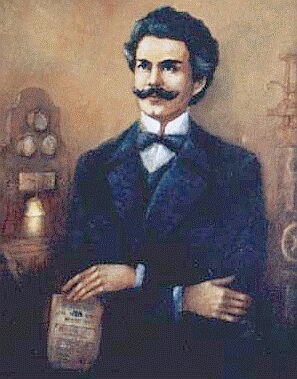>Prominent Poles
Jan Szczepanik , inventor

Born: April 13, 1872, Rudniki, Austro-Hungarian partition of Poland, (presently Poland)
Died: April 18, 1926, Tarnow, Poland
Early days. He was born to a poor peasant family. His mother, Maria Rudnicka, died early and he was raised by his aunt. Salomea Gradowicz. Szczepanik went to an elementary school in Krosno. Further education he got in a”gimnazjum”(high school) in Jaslo where he has shown mathematical talents. He did not however finish the “gimnazjum” but moved to Cracow where he finished a Teachers’ College.
Educational career. Szczepanik worked as an elementary school teacher in Potok, Lubartowka and Korczyn, all in Krosno area. During this time he was interested in weaving and observed the hard work of the weavers using primitive devices. He wanted to help those people and improvement of their lot became his real passion.
Early inventions. In 1896 he abandoned his teaching position and moved to Cracow with the help of Korczyn’s Weavers Association. After initial disappointments he was able to get support from a Galician financier, Ludwik Kleinberg. Thanks to this he devised a very efficient method of multicolor weaving allowing for much faster weaving of gobelins. In 1896 he patented this method in Germany and in England. During WWI German industry got interested with his invention. Szczepanik was supposed to make for the German government a gobelin many dozens yards long. This gobelin was to to represent an apotheosis of great German victories. In 1916 German representatives visited Szczepanik in Tarnow to show him drawings of German designers. The defeat of Germany interrupted this project. Attempts of using this invention failed in France, Belgium and in Cracow.
Vienna. During the period 1898-1902 Szczepanik lived and worked in Vienna where he had his workshop. He was visited by many European industrialists. On February 28,1898 Szczepanik got a patent for his “Fernseher” or “Telektroscop”( apparatus for tele-reproduction of images and sound using electricity). He then made a public presentation of his device. This presentation was noticed by the press and articles appeared in “Reichswehr”, Vienna on March 9, 1898 and in “Neue Wiener Tagblatt” , Vienna, on March 17 1898. Also Mark Twain, who stayed in Vienna from September 1897 till May 1899, visited and befriended Jan Szczepaniak. Historian Carl Dolmetsch in his work “Our Famous Guest” brings numerous details about the friendship between the American writer and the Polish inventor. Among others he notes that Twain was particularly interested in Szczepanik’s weaving system and even contemplated to commercialize this system in the USA. Twain devoted to Szczepanik two articles. One, “The Austrian Edison keeping school again”, appeared in the Century Illustrated Magazine, New York, August 1898 (see link below) bringing a stunning portrait of the Polish inventor. The second one, “From the London Times of 1904”, appeared in the same magazine in November 1898 and is kind of sci-fi story with Szczepanik being its hero
Family . In 1902 he married Wanda Dzikowska and they moved to Tarnow. They had five children: Andrzej, Zbigniew, Bogdan, Boguslaw (murdered by Gestapo during WWII) and Maria.
Other inventions; recognition. Szczepanik was granted awards by royal courts. Spanish king Alfonso XIII awarded him an order for creating a bullet-proof fabric (invented in 1901), whereas the Austro-Hungarian emperor Franz Josef I relieved him from the mandatory military service, and, fascinated with a photosculptor (apparatus for copying sculptures invented in 1899), gave him a pair of pistols as a souvenir. Before World War I, Szczepanik carried out experiments with photography and image projection, as well as with small format color film. He holds patents for a system of obtaining tri-color photography rasters and equipment for sound recording and playback. Following to the discoverer's idea, AGFA corporation produced its Agfacolor reversible paper; color films were also made for the first time, projecting 24 frames per second. Szczepanik's more significant discoveries include also colorimeter (1906)- a color control tool, and an electric rifle, together with the automation of their production. Szczepanik also worked on a moving wing aircraft, a duplex rotor helicopter, a dirigible and a submarine.
In 1925 he fell seriously ill. His wife and his son Zbigniew transported him back to Tarnow where he died of liver cancer. On April 18, 2002 his monument was unveiled on the Sienkiewicz Square in Tarnow.
This article uses, among others, material from the Wikipedia article "Jan Szczepanik" licensed under the GNU Free Documentation License. :
Wikipedia
with substantial additions from other sources.
Other sources:
Poland
"Fels zum Meer" 1898 article in German
Article in French about Twain and Szczepanik; from Histoire de la television
1898 Twain's article "The Austrian Edison keeping school again" that appeared in The Century Illustrated Monthly Magazine
1898 Twain's article "From the London Times 1904" that appeared in The Century Illustrated Monthly Magazine
Museum in Tarnow
Jacek B. (in Polish)
Return to home page:
Prominent Poles
